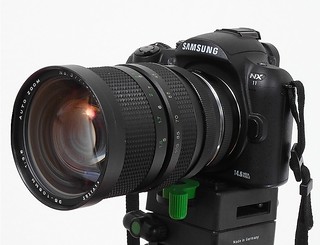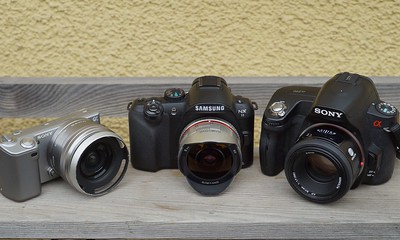Difference between revisions of "Samsung NX11"
(image added) |
m (α) |
||
| Line 21: | Line 21: | ||
|image= https://live.staticflickr.com/65535/51944073651_11a5421416_w_d.jpg | |image= https://live.staticflickr.com/65535/51944073651_11a5421416_w_d.jpg | ||
|image_align= right | |image_align= right | ||
| − | |image_text= <small>NX11 as one of the 14-[[megapixel]] digital [[system camera]]s which were plentifully<br/>introduced especially in the year 2010 which marked the market's switch from<br/>[[DSLR]] to [[CSC]] and the last fight to triumph of [[CMOS]] sensor technology over<br/>[[CCD]] imaging sensors. Three 14-MP-cameras of 2010, from left to right:<br/>[[Sony NEX|Sony α NEX-5]] (CMOS), Samsung NX11 (CMOS), [[Sony DSLR-A290]] (CCD)</small> | + | |image_text= <small>NX11 as one of the 14-[[megapixel]] digital [[system camera]]s which were plentifully<br/>introduced especially in the year 2010 which marked the market's switch from<br/>[[DSLR]] to [[CSC]] and the last fight to triumph of [[CMOS]] sensor technology over<br/>[[CCD]] imaging sensors. Three 14-MP-cameras of 2010, from left to right:<br/>[[Sony NEX|Sony α NEX-5]] (CMOS), Samsung NX11 (CMOS), [[Sony Alpha DSLR-A290|Sony α DSLR-A290]] (CCD)</small> |
|image_by= Uwe Kulick | |image_by= Uwe Kulick | ||
|image_rights= wp | |image_rights= wp | ||
Latest revision as of 11:00, 18 March 2022

|
| image by Which? Tech (Image rights) |
The Samsung NX11 was introduced in late 2010 as a very minor revision to the NX10, with which Samsung had introduced their mirrorless NX system of digital cameras. The most notable change was support for Samsung's i-Function lenses, switchable so that the focus ring can be assigned for use as an extra control wheel adjusting other shooting parameters. The NX11 also offered a slightly restyled handgrip. Other features such as the bright AMOLED view screen and a 14 megapixel Samsung-manufactured sensor remained the same. The apparent pentaprism hump is simply a nod to traditional camera styling, as the camera uses a 920,000-dot electronic viewfinder for eye-level viewing.

|
| w/ adapted zoom lens image by bokina90 (Image rights) |

|
| NX11 as one of the 14-megapixel digital system cameras which were plentifully introduced especially in the year 2010 which marked the market's switch from DSLR to CSC and the last fight to triumph of CMOS sensor technology over CCD imaging sensors. Three 14-MP-cameras of 2010, from left to right: Sony α NEX-5 (CMOS), Samsung NX11 (CMOS), Sony α DSLR-A290 (CCD) image by Uwe Kulick (Image rights) |